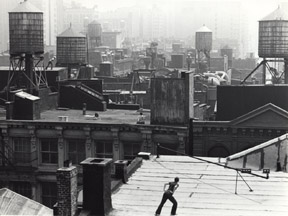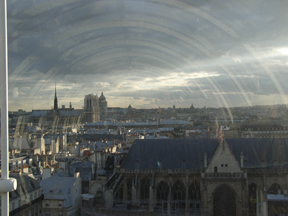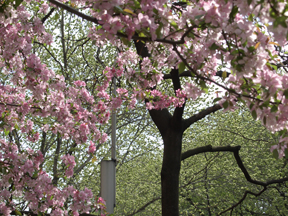| About Roof Piece | |||||||||||||||||||||||||
| How I Made Some of My Films | |||||||||||||||||||||||||
| The Making of Water Motor | |||||||||||||||||||||||||
| Living Somewhere | |||||||||||||||||||||||||
| Collecting as a Creative Process (coming soon...) | |||||||||||||||||||||||||
|
Living somewhere
There? Where? (1979) and Visible Cities (1991) were made specifically to help me live at least temporarily in an alien landscape, one where I found myself because of a job and where I knew I had to find a way to inhabit even if only for a few months. The first film There? Where? was made quickly in two months. I just had that much time to look, learn how to drive and figure out how you could function in a landscape that was so different from the well-traveled streets and avenues of the cities I knew like New York or Paris. At first the impossibility of walking to conquer the distance between things was what was so astonishing. You discovered a land whose topology suddenly made you face the impossible, like finding passage over a canyon and you see that it can’t be crossed in a straight line and needed to be contoured. Learning to drive was the only way you could move in this terrain where rules were all different from the nineteenth century concept of the city with public thoroughfares that I knew. A segregation of usage was practiced; you found one space for work, another one for residence and a lot of empty spaces in between. That nothing ever mixed was a fact of life in the Southern California terrain that was so different from what I had known before. And you saw that once-used, space could be discarded and you could move elsewhere rather than maintain, rebuild, rehab as there were doing in the East and the middle West of the US in the late seventies. All around you, there was still so much of undisturbed “chaparral” name given to the native habitat full of jackrabbit and wild life that it was easier to open up new areas for building than fix the old. What you were confronting was patches of unused spaces or barely lived-in condominiums far away from each other’s and large deserted freeways to connect them all. Looking at it, being immersed in it, you could without effort internalize the island syndrome. The rest of the world isn’t there. You are in your own bubble. Reading and listening to people confirmed what I saw. I was then preparing another investigation of the landscape of the American West from the perspective of the immigrant, the one who just arrives, discovers wilderness and has trouble understanding the concept of it and doesn’t know1. I needed to test how to use voice-over against images of landscape and There? Where? was made to investigate how fragments of dialog would work when they are heard as if floating in space, ungrounded and disconnected from the image. Coming back ten years later, but this time to stay, my second look at the Southern California landscape confirmed the extreme rapidity and fluctuation of what was happening. The next film Visible Cities would take two years to shoot and edit. I needed the time to see how things were built. I wanted to trace an ongoing mutation rather than only get a snapshot of what was there. Having already my own history with the terrain helped me see that time passing was needed2. I knew that what I was witnessing was visually interesting although only editing of succeeding stages could help reveal it. You had to circle around the construction sites bringing to the fore the classic problematic of where to live and how. A story that is everyone’s story but here you plan to buy before it is built. You have to imagine the future. The concept of home is also skewed toward the private as the essential luxury, negating how privacy at all cost is linked to an absence of community that can be debilitating. I decided that I was going to shot the colonization of the land by shooting over two winters when the light is clearer and the pollution doesn’t show. That should give me enough time to see things built and meanwhile I did a lot of reading about Southern California’s history in particular Mike Davis’s book City of Quartz. I wanted to show how one usage replaces another one, in my case in Del Mar north of San Diego in a wealthy area close to the beach, how greenhouses were displaced to make way for a rapid buildup of instant cities. How to define those cities was my task. One question imposed itself. Are cities and homes the same thing? I had always admired Italo Calvino’s books and at some point I was reminded of his book Invisible Cities that I had read many years before. What better than a dialog between opposite concepts of cities, as imagined by Calvino? His dialog was between the nomadic ruler from Asia Kublai Khan and from the merchant city of Venice in its splendor as the gateway to the Orient, the great traveler Marco Polo. Khan and Polo imagine multiple kinds of cities and it was the multiplicities of the various possible that fascinated me. In my case I decided on two average women, not wealthy and instead of being rulers and powerful they would feel threatened. As in Calvino’s book, my two women would engage with the philosophical underpinning of what they saw or imagine could be. I needed something to justify my circling around the terrain and found the key to my structural problem by inventing two women looking at it. That decision of grounding my protagonists in their imaginary helped transform what could have been just a documentary look at the land into a reflection about what is home. Still today, I feel that concretely imagining living somewhere
and doing it are intertwined. We continue reinventing what we do.
1The film The Sky on Location was made the following year. In addition to pictorialism and wilderness the film explores how looking at empty spaces free the mind from preconceived ideas as the changing light acts as a source of endless stimulation and demonstrates to the spectator the concept of transience. 2It is almost astonishing to think that both films There? Where? (1979) and Visible Cities (1991) were shot in many of the same places although it is invisible to today’s viewers unless they themselves were there and lived through those transformations as what was before has been erased. That history could be erased was what I found so appalling and wrong and it informed the dialog in Visible Cities. |



